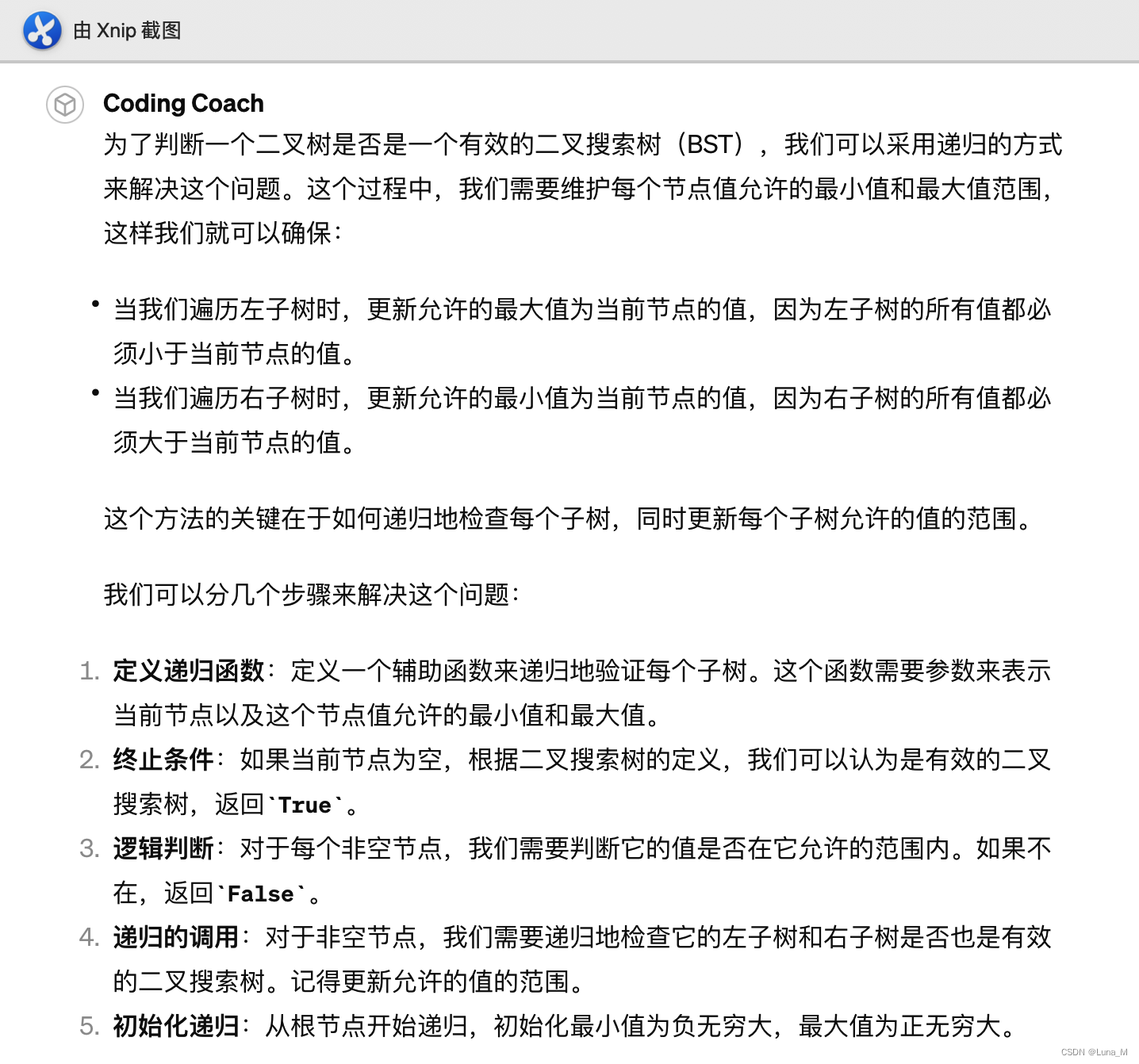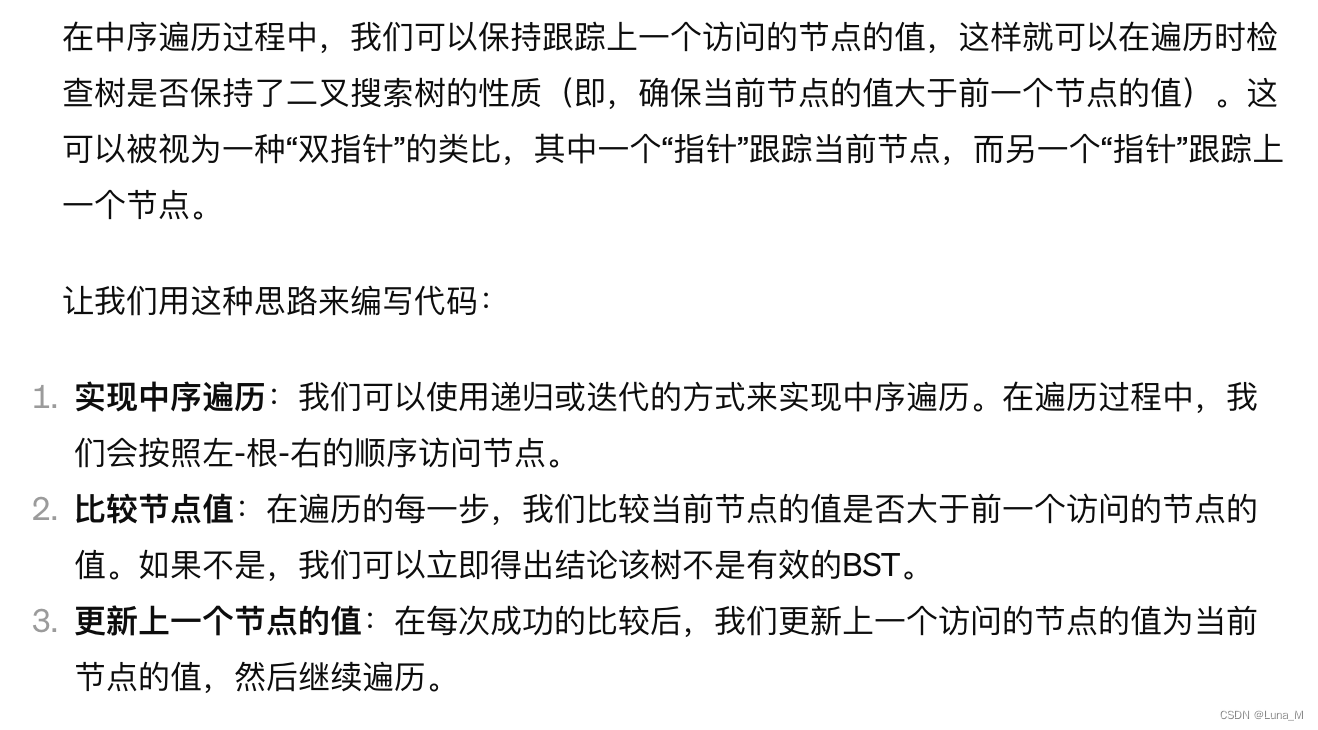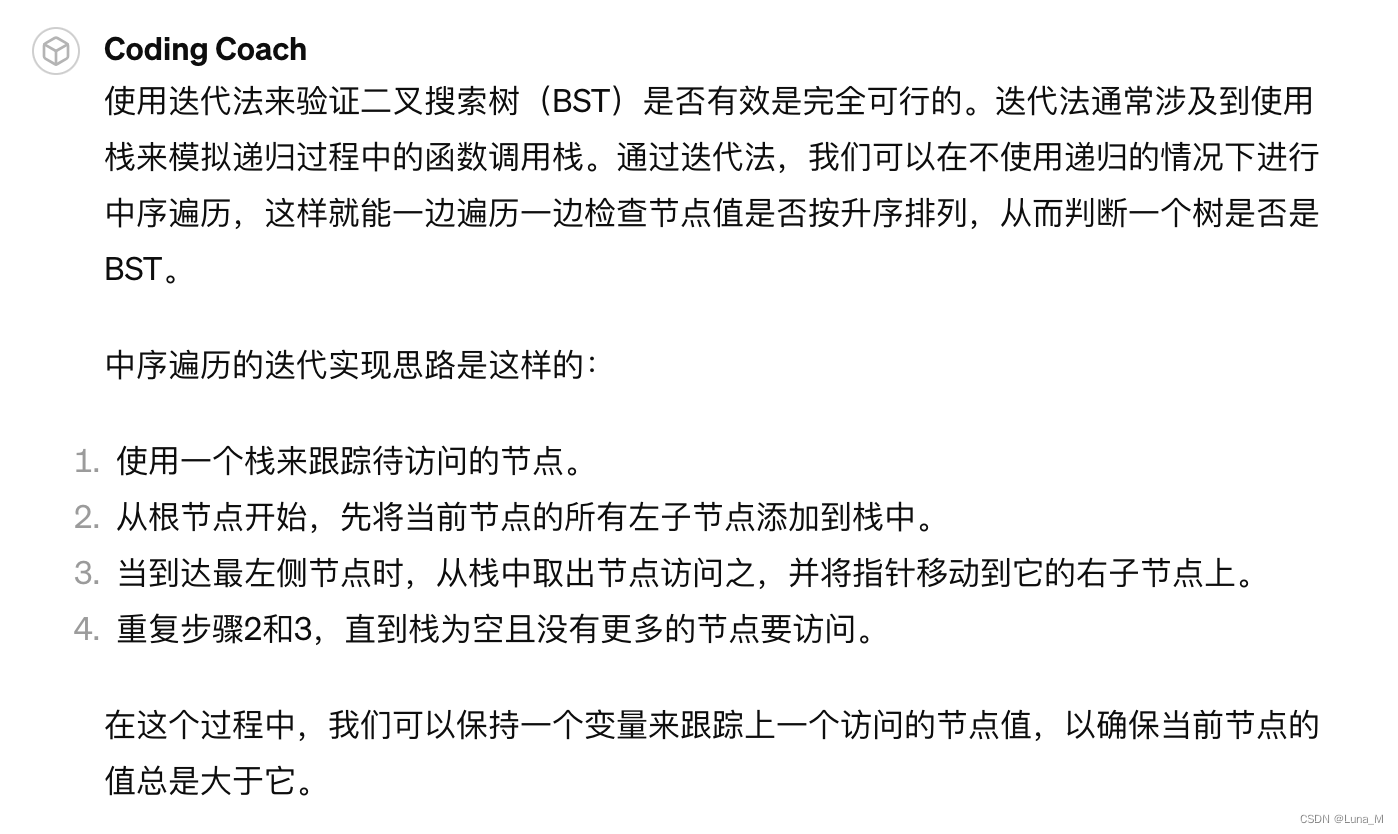相关推荐
python coding with ChatGPT 打卡第12天| 二叉树:理论基础
python coding with ChatGPT 打卡第13天| 二叉树的深度优先遍历
python coding with ChatGPT 打卡第14天| 二叉树的广度优先遍历
python coding with ChatGPT 打卡第15天| 二叉树:翻转二叉树、对称二叉树
python coding with ChatGPT 打卡第16天| 二叉树:完全二叉树、平衡二叉树、二叉树的所有路径、左叶子之和
python coding with ChatGPT 打卡第17天| 二叉树:找树左下角的值、路径总和
python coding with ChatGPT 打卡第18天| 二叉树:从中序与后序遍历序列构造二叉树、最大二叉树
python coding with ChatGPT 打卡第19天| 二叉树:合并二叉树
二叉搜索树中的搜索
Key Points
1.二叉搜索树是一个有序树:
- 若它的左子树不空,则左子树上所有结点的值均小于它的根结点的值;
- 若它的右子树不空,则右子树上所有结点的值均大于它的根结点的值;
- 它的左、右子树也分别为二叉搜索树
2.二叉搜索树的迭代
一提到二叉树遍历的迭代法,可能立刻想起使用栈来模拟深度遍历,使用队列来模拟广度遍历。
对于二叉搜索树可就不一样了,因为二叉搜索树的特殊性,也就是节点的有序性,可以不使用辅助栈或者队列就可以写出迭代法。
对于一般二叉树,递归过程中还有回溯的过程,例如走一个左方向的分支走到头了,那么要调头,在走右分支。
而对于二叉搜索树,不需要回溯的过程,因为节点的有序性就帮我们确定了搜索的方向。
相关题目
视频讲解
重点分析
方法一:
递归法
def searchBST(root, val):
if not root:
return None
if root.val > val:
return searchBST(root.left, val)
if root.val < val:
return searchBST(root.right, val)
return root
方法二:
迭代法
def searchBST(root, val):
current = root
while current:
if current.val > val:
current = current.left
continue
if current.val < val:
current = current.right
continue
else:
break
return current
验证二叉搜索树
Key Points
在中序遍历下,输出的二叉搜索树节点的数值是升序序列。
相关题目
视频讲解
重点分析
方法一:
不使用有序序列

我们可以定义一个辅助函数checkBST,它接收四个参数:当前节点node、minVal(当前节点值允许的最小值)、maxVal(当前节点值允许的最大值)、以及初始的根节点root。这个辅助函数将帮助我们递归地验证每个子树,同时保持跟踪允许的值的范围。
def checkBST(node, minVal, maxVal):
if not node:
return True
if node.val <= minVal or node.val >= maxVal:
return False
return checkBST(node.left, minVal, node.val) and checkBST(node.right, node.val, maxVal)
def isValidBST(root):
return checkBST(root, float('-inf'), float('inf'))
这段代码使用了一个嵌套的辅助函数checkBST来递归地验证每个节点是否符合二叉搜索树的条件,它通过维护每个节点的值允许的最小值和最大值来实现。这种方法能够确保所有的左子树节点都小于它的父节点,并且所有的右子树节点都大于它的父节点,同时还考虑了所有祖先节点的约束条件。
方法二:
使用有序序列 + 双指针 递归法

class Solution:
def __init__(self):
self.pre = None # 用来记录前一个节点
def isValidBST(self, root):
if root is None:
return True
left = self.isValidBST(root.left)
if self.pre is not None and self.pre.val >= root.val:
return False
self.pre = root # 记录前一个节点
right = self.isValidBST(root.right)
return left and right
方法三:
使用有序序列 + 双指针 迭代法

def isValidBST(root):
stack = []
prev = None
while stack or root:
# 遍历到最左
while root:
stack.append(root)
root = root.left
# 访问节点
root = stack.pop()
# 检查当前节点是否大于前一个节点
if prev and root.val <= prev.val:
return False
prev = root
# 转向右子树
root = root.right
return True
二叉搜索树的最小绝对差
Key Points
- 在升序数组中,任意两个相邻元素的差值最小
- 1)暴力法:先中序遍历得到升序数列,再遍历数组求最小差值;
2)简化法:遍历的过程中使用双指针
相关题目
视频讲解
重点分析
方法一:
递归法
class Solution(object):
def __init__(self):
self.pre = None
self.diff = float('inf') # 只使用一次,所以是全局变量
def getMinimumDifference(self, root):
self.in_traversal(root)
return self.diff
def in_traversal(self, root):
if not root:
return
self.in_traversal(root.left)
if self.pre:
self.diff = min(root.val - self.pre.val, self.diff)
self.pre = root
self.in_traversal(root.right)
return
方法二:
迭代法 + 暴力
def getMinimumDifference(root):
stack_record = []
current = root
res = []
while stack_record or current:
while current:
stack_record.append(current)
current = current.left
current = stack_record.pop()
res.append(current.val)
# 左中都处理完了,转向右
current = current.right
i = 0
j = i+1
diff = res[j] - res[i]
while j < len(res):
diff = min(res[j] - res[i], diff)
i += 1
j += 1
return diff
注:LeetCode题目中说明节点至少为两个,所以使用双指针不用讨论数组长度
方法三:
迭代法+简化
def getMinimumDifference(root):
stack_record = []
current = root
diff = float('inf')
pre = None
while stack_record or current:
while current:
stack_record.append(current)
current = current.left
current = stack_record.pop()
if pre is None: # if not pre 不行,警惕0的情况
pre = current.val
else:
diff = min(current.val-pre, diff)
pre = current.val
current = current.right
return diff
二叉搜索树中的众数
Key Points
首先如果不是二叉搜索树的话,应该怎么解题,是二叉搜索树,又应该如何解题,两种方式做一个比较,可以加深大家对二叉树的理解。
- 如果不是二叉搜索树,最直观的方法一定是把这个树都遍历了,用map统计频率,把频率排个序,最后取前面高频的元素的集合。
- 对于二叉搜索树,遍历有序数组的元素出现频率,从头遍历,那么一定是相邻两个元素作比较,然后就把出现频率最高的元素输出就可以了。
相关题目
视频讲解
重点分析
方法一:
暴力法 哈希表(迭代)
def findMode(root):
res = []
stack_record = []
current = root
while stack_record or current:
while current:
stack_record.append(current)
current = current.left
current = stack_record.pop()
res.append(current.val)
current = current.right
record = {}
for x in res:
record[x] = record.get(x, 0) + 1
record_sort = sorted(record.items(), key=lambda x:x[1], reverse=True)
results = []
max_val = record_sort[0][1]
for x in record_sort:
if x[1] == max_val:
results.append(x[0])
else:
break
return results
方法二:
遍历两遍 双指针 (迭代法)
def findMode(root):
res = []
stack_record = []
current = root
while stack_record or current:
while current:
stack_record.append(current)
current = current.left
current = stack_record.pop()
res.append(current.val)
current = current.right
pre = None
count = 0
max_count = 0
results = []
for x in res:
if pre is not None:
if pre == x:
count +=1
else:
count = 1
else:
count = 1
pre = x
if count == max_count:
results.append(x)
elif count > max_count:
max_count = count
results = [x]
return results
方法三:
遍历一遍 迭代法
def findMode(root):
res = []
pre = None
max_count = 0
count = 0
stack_record = []
current = root
while stack_record or current:
while current:
stack_record.append(current)
current = current.left
current = stack_record.pop()
if pre:
if current.val == pre.val:
count += 1
else:
count = 1
else:
count = 1
pre = current
if count == max_count:
res.append(current.val)
elif count > max_count:
max_count = count
res = [current.val]
current = current.right
return res
方法四:
遍历一遍 递归法
class Solution:
def __init__(self):
self.pre = None
self.res = []
self.max_count = 0
self.count = 0
def in_traversal(self, root):
if not root:
return
self.in_traversal(root.left)
if self.pre:
if root.val == self.pre.val:
self.count += 1
else:
self.count = 1
else:
self.count = 1
self.pre = root
if self.count == self.max_count:
self.res.append(root.val)
elif self.count > self.max_count:
self.max_count = self.count
self.res = [root.val]
self.in_traversal(root.right)
return
def findMode(self, root):
self.in_traversal(root)
return self.res





















 1122
1122











 被折叠的 条评论
为什么被折叠?
被折叠的 条评论
为什么被折叠?








